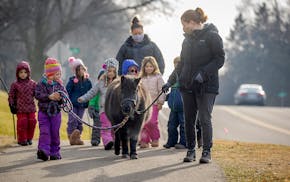For more than a decade, the sound of gunshots was commonplace for Ibrahim Eltahan, who works the counter at Winner Gas Station in north Minneapolis. Some grimly refer to it as the "murder station."
But on Wednesday, four days after the city saw the end of its longest stretch without a homicide in over eight years, Eltahan said he's noticed a marked decrease in gunfire.
"I feel better, and for like three years now it's been better," said Eltahan, who has worked at the gas station at the intersection of Broadway and Lyndale avenues N. for about 20 years. "The area here I see is so different."
Minneapolis went 62 days without a homicide — starting Feb. 15 and ending the night of April 18, when a man in his 20s was shot near the intersection of 5th Avenue S. and 9th Avenue S. in downtown Minneapolis. He died from his injuries on Thursday and has not been publicly identified. It was one of the longest gaps between homicides in recent history.
The last year that came close was 2017, when there were 45 days without a homicide between January and March.
"I think it's quite significant, considering just all of the turmoil and the trauma that everyone in this community has been through over the last nearly five years," Minneapolis Police Chief Brian O'Hara said Wednesday.
The time of year is a factor — the freezing winter and early spring are typically when Minneapolis sees its lowest numbers of violent crime before ramping up in the summer. Still, O'Hara said the extended lull is a positive sign and a much-needed win for a city that's endured a spike in shootings since the pandemic and the killing of George Floyd.
O'Hara attributed the gap in homicides and recent positive trends to both his department's efforts and partnerships with community organizations, residents and other agencies.
He pointed directly to strategies the police have taken such as finding and arresting a small number of high-impact offenders, issuing an order to "empower" officers to clear homeless encampments and creating the curfew task force that connects investigators with families of children who have committed crimes and works to prevent them from reoffending.
In the Willard Hay and Near North neighborhoods, Gayle Smaller said he's seen major reductions in drug dealing and prostitution on the streets since 2023.
"There's certain areas right off of Plymouth [Avenue] where we didn't even know kids lived in the neighborhood because parents wouldn't let them outside, and now they play in the streets," said Smaller, who works for the organization Northside Residents Redevelopment Council.
In the two years preceding the pandemic, Minneapolis did not come close to matching 2025's lull in homicides. The next longest were two 33-day stretches in 2018: one between September and October, and another between December and early January 2019.
The downward trend of homicides is not specific to Minneapolis or Minnesota — the United States has seen a nearly 21% decrease in murders so far this year compared to the same time last year, according to the Real-Time Crime Index, which compiles murder statistics from 381 law enforcement agencies.
Michelle Phelps, a professor of sociology at the University of Minnesota, stressed that it's important to not read too much into one statistic. She said public safety should be viewed in a holistic way by factoring in the disruptions of the pandemic, such as kids being out of school, financial insecurity and overall grief in communities.
"One of the things the pandemic taught us, particularly in Minneapolis, is that while police play an important role in responding to homicides and can have some impact on those rates, lots of other things are driving homicides up or down," Phelps said.
Still, she said, "any period where you go some number of months without a homicide is wonderful news."
O'Hara noted that while he thinks there has been a "perfect storm" with many residents and organizations helping to deter crime, police response has been a crucial component.
"I think the violence we were experiencing, and kind of the psychological effect that had on the community at large, needed a strong law enforcement response to that, and I think we're starting to see the results from that," he said.
While some residents are noticing reductions in crime, others remain just as concerned. At a recent community meeting for the Standish-Ericsson Neighborhood Association, resident Matt Guest said there's been insufficient police presence in his area. Others said they've been more fearful after their neighbor Boyd Hansen was shot in the jaw in February by suspects in a recent crime spree.
"It's seemingly a joke when [my neighbor] can get shot in the face, and two blocks over they're continuing to rob garages, including in my alleyway, while there's a quote unquote 'police presence,'" he said.
O'Hara, who moved from New Jersey to Minneapolis to take the job as chief in 2022, said he realizes there are difficulties caused by the department being short-staffed. But he also said he thinks the outlook is positive for the city's public safety trends.
"We're approaching levels that were normal for this city prior to 2020, and we're able to do this despite having half the police department walk away," said O'Hara. "I think it's incredibly remarkable."
Jeff Hargarten of the Minnesota Star Tribune contributed to this story.

Thompson found guilty of murder in car crash that killed 5 young women

University of Minnesota is putting its golf course up for sale
Supreme Court allows DOGE team to access Social Security systems with data on millions of Americans
Feeding Our Future probe: Apple Valley woman charged with defrauding food program of $1.4 million
